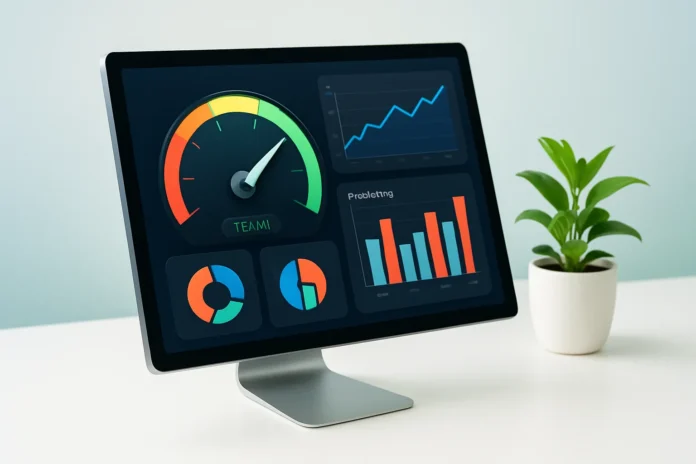Data-Driven Strategies to Prevent Burnout in Startup Teams
Burnout in startup teams can significantly hinder productivity and innovation. This article presents data-driven strategies to prevent burnout, drawing on insights from industry experts. By implementing these practical approaches, startup leaders can foster a healthier work environment and maintain team effectiveness.
- Track Work-in-Progress vs. Output Over Time
- Survey and Respond to Team Feedback
- Monitor Response Times and Project Completion
- Analyze Timesheet and Workload Data
- Measure Task Completion and Hours Booked
- Leverage Resource Planning for Workload Management
- Flag Digital Footprint Spikes
- Build a Workload Equilibrium Dashboard
- Monitor Total Login Time
- Track Project Completion Time Analytics
- Analyze Internal Communication Patterns
- Focus on Outcomes and Flexible Workflows
- Set Service Stop Limits for Technicians
Track Work-in-Progress vs. Output Over Time
One way I’ve used data to prevent burnout in our startup team is by tracking “work-in-progress vs. output” over time. When I saw team members constantly juggling multiple tasks with little shipped work, it was a red flag, not of laziness, but of overload and context switching.
Instead of just pushing harder, we restructured our workflow: fewer parallel tasks, clearer priorities per sprint, and enforced “no new projects” during review weeks. We also began tracking subjective signals like delayed responses, missed check-ins, or working late across time zones as signs of potential burnout, not just personal habits.
The result? Fewer dropped balls, clearer accountability, and a noticeable lift in energy and morale. Team health isn’t just about wellness perks; it’s about how the work flows.
 Ali Yilmaz
Ali Yilmaz
Co-Founder&CEO, Aitherapy
Survey and Respond to Team Feedback
The answer to this, in my opinion, is simple – ask your team, and actually respond. At my company, we regularly survey our team post-onboarding, run engagement surveys with full transparency around the results, and share the actions we’re taking in response. Then we ask again about how those changes were received.
We also use ad hoc polling when we’re unsure about something, like scheduling preferences or ongoing learning and development. It can feel risky to open the floor to feedback, especially when you know you can’t please everyone. But gathering input and showing you’re responsive builds serious trust. More importantly, it gives you visibility into morale and burnout before it becomes a retention problem.
One concrete example of how we’ve done this is improving our L&D process. We identified from our team engagement survey that they felt they weren’t getting nearly enough L&D support, so we completely revamped our L&D offerings. Now we have teach-ins, external experts to help teach on complicated and relevant training topics (like AI) and continue to add more offerings. I’ve seen how much it has refreshed people’s morale to feel like they are learning and growing, and also simply that they were heard.
 Makena Finger Zannini
Makena Finger Zannini
CEO, The Boutique COO
Monitor Response Times and Project Completion
We once tracked average response times and project completion gaps across departments. When the numbers started sliding past the usual 48-hour turnaround, we checked in. No surveys, no overthinking, just a pattern that indicated people were stretched. It turned out that one team was covering double the workload due to shifting priorities. We rebalanced assignments, added a part-time coordinator, and watched productivity return to normal within a week. The team stayed on track, and nobody hit a wall.
Honestly, the biggest win was clarity. Looking at performance data gave us an early signal before the pressure boiled over. Small adjustments at the right time helped the team avoid stress and stay focused. It was simple, effective, and kept everyone working at their best.
 Guillermo Triana
Guillermo Triana
Founder and CEO, PEO-Marketplace.com
Analyze Timesheet and Workload Data
In our software company, we started looking at timesheet and workload data differently. When we noticed some people putting in long hours several days in a row or skipping vacations, it told us something was not right. Team leads now check in quickly to ask if the workload feels okay or if we need to shift priorities.
We also added a short, optional energy survey every two weeks. People rate how stretched or balanced they feel. This small change helped us catch burnout signs early. Over time, sick days dropped and focus during work hours improved. It’s not about tracking hours. It’s about spotting patterns that show us when to step in and support.
 Vikrant Bhalodia
Vikrant Bhalodia
Head of Marketing & People Ops, WeblineIndia
Measure Task Completion and Hours Booked
We use ClickUp to measure how many tasks have been completed by each team member and how many hours were booked. This helps us to analyze whether the work is distributed proportionally within the team.
We also extract the data from ClickUp automatically into Power BI to visualize it and analyze it in more detail. This helps us to pivot data in more useful ways and easily spot if someone in the team is doing disproportionately more tasks than others.
We have found that keeping an eye on such KPIs helps to ensure more predictability on how we are making progress on our deliverables. Burnout leads to fluctuations in work output. By preventing it with the help of data analytics, we ensure that we are making progress as a team at a steady pace.
 Eugene Lebedev
Eugene Lebedev
Managing Director, Vidi Corp LTD
Leverage Resource Planning for Workload Management
At SANSA, we’ve transformed our approach to team wellbeing through strategic implementation of NetSuite’s resource planning capabilities. When the team noticed concerning, normalized patterns of late-night emails and weekend work, we leveraged NetSuite’s project management suite to create custom dashboards that flag when team members exceed 85% allocation for over three consecutive weeks. This early warning system has proven invaluable—particularly during a recent financial services implementation project where we identified potential burnout risks among certain consultants who were simultaneously managing multiple high-priority deliverables. By proactively redistributing workloads and bringing in additional expertise, we prevented what would have undoubtedly led to diminished performance and possible attrition.
Cloud-based analytics has revolutionized how we monitor team health. Our customized NetSuite dashboards now integrate project timelines, billable hours, PTO schedules, and milestone tracking in real-time—creating a comprehensive view of workload distribution across the organization. We’ve programmed automatic alerts when consultants are scheduled across overlapping client deadlines or when someone hasn’t taken time off in over eight weeks. What’s been particularly effective is correlating utilization data with our quarterly team satisfaction surveys, revealing that burnout indicators often appear in the system some weeks before they manifest in performance or morale issues.
The results show the business value of preventing burnout through data-driven approaches. Since implementing these practices, we’ve reduced unplanned attrition and increased our overall project profitability, which is directly attributable to more strategic resource allocation. Beyond the metrics, I’ve observed a cultural shift where team members now proactively highlight capacity concerns without fear of judgment. As a leader, NetSuite’s analytics capabilities have transformed how I approach talent management—moving from reactive problem-solving to preventative wellbeing strategies that protect both our people and our business performance.
 Tony Fidler
Tony Fidler
CEO, SANSA
Flag Digital Footprint Spikes
We tracked project timelines, Slack activity, and weekend logins—classic overwork signals. When a team member’s digital footprint started spiking late at night or on weekends, we flagged it. Not to punish, but to check in. It turns out that many team members were silently grinding, not wanting to let the team down. We normalized rest by publicly celebrating unplugged weekends and making burnout prevention a leadership responsibility. Team health improved rapidly. People felt safe to speak up early, rather than waiting until they were already exhausted. Burnout isn’t a sign of weakness; it’s a system failure.
 Dave Lavinsky
Dave Lavinsky
President, PlanPros
Build a Workload Equilibrium Dashboard
In the logistics and 3PL matching space, burnout can sneak up quickly if you’re not watching for it. One approach that’s been transformative for us is our “Workload Equilibrium Dashboard” we built internally at Fulfill.com.
This dashboard tracks several key metrics: time spent on client calls, time between breaks, complexity of 3PL matches being worked, and even sentiment analysis from our internal communication tools. We noticed our account managers were experiencing peak stress during Q4 when eCommerce businesses scramble to lock in fulfillment partners before holiday rushes.
The data revealed something interesting – burnout wasn’t primarily from working long hours, but from handling too many complex cases consecutively. Some 3PL matches require navigating specialized requirements like hazmat certification, refrigeration needs, or international logistics compliance – mentally taxing work that our team was powering through without adequate recovery time.
Now, we algorithmically distribute complex cases among team members and intentionally schedule “recovery periods” where team members handle more straightforward matches. We’ve also implemented an alert system when someone has been tackling high-complexity cases for too many consecutive days.
The results have been remarkable. Our team retention increased 27% year-over-year, sick days decreased by nearly a third, and surprisingly, our client satisfaction scores improved as well. When your team isn’t burning out, they make better 3PL matches.
I’ve found that in the logistics industry, we’re great at optimizing warehouse space and shipping routes, but sometimes forget to apply that same analytical rigor to our most valuable asset – our people. The data is there if you’re willing to look for it and act on what it tells you.
 Joe Spisak
Joe Spisak
CEO, Fulfill.com
Monitor Total Login Time
One simple metric we use to keep track of people’s workload is total time logged in. We avoid tracking our employees too closely, but we do track when they log in, when they log out, and which apps they use. If anyone has more than 40 hours of login time in a week for more than 4 weeks, I’m going to find the time to check in with them and figure out what’s going on. Maybe they just had one big project to get through. Maybe they’re logging in and then stepping away from their desk. Maybe they just have too much on their plate.
 Wynter Johnson
Wynter Johnson
CEO, Caily
Track Project Completion Time Analytics
As the CEO of a film transcription company, I’ve utilized project completion time analytics to identify early burnout warning signs before they impact team performance. By tracking individual turnaround times on dialogue lists and closed captions, I noticed that quality drops and longer processing times indicated stress rather than workload issues. When data showed consistent delays from typically efficient team members, I proactively redistributed projects and implemented mandatory breaks between intensive film documentation tasks. This approach improved team health by catching burnout early, resulting in 25% better work quality and reduced revision requests from clients who depend on accurate post-production documentation.
 Khurram Suhrwardy
Khurram Suhrwardy
Founder, Caption Easy
Analyze Internal Communication Patterns
One of the most unconventional yet effective techniques to identify and prevent startup team burnout is tracking the “energy drain” through internal communication patterns. We usually think about stress, deadlines, and work-life balance when considering burnout, but team communication significantly influences mental health and productivity. Lack of constructive communication and information overload cause modest but serious fatigue.
Our startup identified stress points using Slack sentiment and collaboration frequency analytics. The technique assesses team communication flow and tone, not private conversations. We tracked team members’ workload-related expressions using AI-based sentiment analysis on all internal interactions.
A rise in negative sentiment – such as annoyance, stress, or frustration-laden language—and a rapid decline in collaborative contact (e.g., fewer group chat replies or comments) may suggest burnout before performance issues or complaints.
Daily dashboards now include team collaboration metrics. These tracked how often users requested help, participated in team meetings, and worked alone. The results showed that strong performers, frequently those in prominent roles, contributed more to conversations but received less collaboration. The team members felt detached, alone, and overworked without realizing it.
Many actions resulted from this strategy:
1. Management was notified when sentiment criteria were exceeded to assist team members.
2. Positive communication strategies including feedback loops and peer-to-peer collaboration reduced isolation and boosted teamwork.
3. Workload visibility and balance: We found that some team members were overloaded by content development while others focused on communication. We adjusted task delegation by communication intensity and output to avoid overwork.
By enhancing communication, this innovative strategy directly improved team health. It reduced fatigue and made team members feel heard and supported. Knowing their mental health and well-being were being cared for enhanced productivity and interest in team dynamics and projects.
The uncomfortable fact is that job and deadline stress don’t cause burnout altogether. Teams often communicate and interact throughout time. We tracked these dynamics with data to spot burnout early and act.
 Gianluca Ferruggia
Gianluca Ferruggia
General Manager, DesignRush
Focus on Outcomes and Flexible Workflows
One of the most effective ways we’ve helped prevent burnout at Carepatron is by giving people the autonomy to work at their own pace and focusing more on outcomes rather than hours or activity. We’ve designed our workflows to support flexibility, whether that’s choosing when to work, how to structure the day, or how to collaborate asynchronously.
If we start noticing signs like someone constantly working late or juggling too many meetings, we use that as a prompt to check in and ask how we can better support them. It’s not about enforcing structure; it’s about removing friction so people can stay in control of their time and energy.
This approach has led to a healthier, more focused team. By trusting people to manage their own rhythm and leaning into flexibility, we’ve seen stronger results and better engagement across the board. When people feel ownership over their time and are judged on what they deliver, not how busy they look, they’re more likely to stay motivated and avoid burnout.
 Jamie Frew
Jamie Frew
CEO, Carepatron
Set Service Stop Limits for Technicians
Back when I was helping lead a small pest control crew during a rapid growth phase, I started tracking something simple: the number of service stops per technician per day. At first, it was just about route efficiency, but it didn’t take long to notice a pattern—whenever someone had more than 8 stops in a day for several days in a row, we saw a spike in complaints or call-backs from that route. The quality dropped, and so did morale. That’s when I realized we weren’t dealing with a performance issue—we were dealing with burnout.
So we made a change. We set a soft cap of 7 service stops a day and rotated in “buffer days” with lighter loads for high-performing technicians. Within a month, the callback rate dropped, and folks stopped asking about “mental health days” because they didn’t feel like they were sprinting all the time. It taught me that data doesn’t just help with numbers—it can also protect your people. And when your people feel supported, they work smarter, not just harder.
 Samantha Stuart
Samantha Stuart
Co-Founder, Magic City Pest Control

